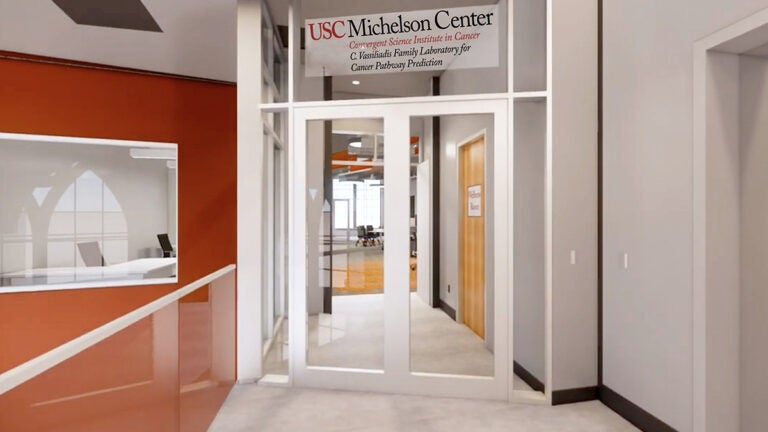
New laboratory space promotes ‘happy collisions’ among scientists
Peter Kuhn recently took a stroll through what, sometime in spring 2021, will be the new home for his Convergent Science Institute in Cancer (CSI-Cancer) lab.
The space, which will encourage collaboration between undergraduates, graduate students, faculty, staff and clinical collaborators with expertise in physics, chemistry and biology, is one level below the lab’s current location, on the third floor of Michelson Hall on the University Park campus.
But it will be a whole new world.
“It’s one of those places that just exudes innovation,” says Kuhn, Dean’s Professor of Biological Sciences and professor of biological sciences, medicine, biomedical engineering, aerospace and mechanical engineering and urology at the USC Dornsife College of Letters, Arts and Sciences, as well as a founding member of the USC Michelson Center for Convergent Bioscience.
Designed to promote collaboration
Kuhn is a scientist, educator and entrepreneur with a career-long commitment to personalized medicine and individualized patient care. CSI-Cancer’s new home is designed to encourage what he calls “happy collisions” between motivated scientists, students and clinicians as they work to improve outcomes for cancer patients.
“When we talk about ‘convergent’ science,” Kuhn explains, “we accept that we have problems on this planet that are highly complex, and neither the problem nor the solution is owned by a particular discipline. It’s an unclear starting point.
“We decided to make the patient the starting point of convergence. Then we start aligning disciplines around the patient.
“Collaborative spaces also need to provide for areas that are quiet and allow to focus,” he adds. “For that reason, the center of the new space will serve as that quiet area that visually will be separated from the interactions spaces but without walls. Careful design using sound-reduction elements overhead as well as overall workflow will allow people to focus on their individual work while only being steps away from ‘happy collisions’ with colleagues.”
The labs will have floor-to-ceiling glass walls and doors inside as well as windows to the outside world, creating an open and freeing environment that is flooded with daylight.
“You break down barriers when meetings are out in the open,” says Kuhn. “You encourage the exploration of new ideas. That was our design mantra for this new space.”
The second floor of Michelson Hall also will house a lab run by Professor of Physics and Astronomy and Chemistry Moh El-Naggar, whose research is very different from Kuhn’s, but whose lab exudes the same interdisciplinary and collaborative vibe.
El-Naggar, whose work focuses on real or engineered bacteria applied to electronics, and Kuhn both say the new space will improve their research capabilities.
“Physics, chemistry, biology — we teach these subjects as if they’re different, but our research doesn’t really work that way anymore,” said El-Naggar, the Robert D. Beyer Early Career Chair in Natural Sciences.
From prototype labs to room for growth
CSI-Cancer launched as an initiative at USC six years ago in custom-built trailers in a parking lot.
These temporary labs were designed as prototypes for the future. Three years ago, shortly after Michelson Hall opened, Kuhn moved his lab into the third floor of the building, where the scientific program grew rapidly. Soon, his lab will be in its designated home on the second floor, an even-more ideal space.
“There’s a feeling of transparency, and an emotional aspect of openness and working together,” he says. “It’s designed for us to have a sustained conversation over time. It’s not just a place to work and meet. It’s a place for an ongoing dialogue.”
CSI-Cancer today has a team of more than 15 graduate students and postdoctoral fellows and has built an experiential undergraduate program called CURE that currently has 28 students. Complemented by a dozen professional staff, science and faculty team members, the new lab provides ample space to scale up to about 75 scientists.
Survivor helps make the new space possible
The new CSI-Cancer lab was made possible by a gift from Carol Vassiliadis, a cancer survivor who lost her husband, Alkiviadis “Laki” Vassiliadis, to colon cancer in 2002.
Carol Vassiliadis met Kuhn about a decade ago at a dinner and was taken with his vision for CSI-Cancer.
“I was convinced he was the right man to do this job because he is the smartest man I know,” says Vassiliadis, who has been cancer free for 12 years. “I thought, ‘This problem needs to be solved.’”
Under one roof
El-Naggar and his team of 15 in his biophysics lab study such things as using bacteria to make biofuels or to convert solar energy to electrical energy. His lab’s primary focus is using bacteria to create living sensors and electronics —for example, to detect a certain contaminant in the environment.
“There were limitations in terms of what my lab could do in spaces that were designed 40 to 50 years ago with a very narrow purpose in mind,” he says. “That’s not the reality of what a lot of us do anymore.”
El-Naggar is as thrilled as Kuhn about the upcoming move.
“In my current space, we have one room down the hall that is basically our wet space, and another room down the end of another hall where it’s my instrumentation space,” he says. “Now, we’ll all be under one common roof.
“I’m excited about all the science that will be done in this beautiful new space. It’s really going to be a great hub of activity.”
Have comments or questions about this story? Submit them to communication@dornsife.usc.edu.